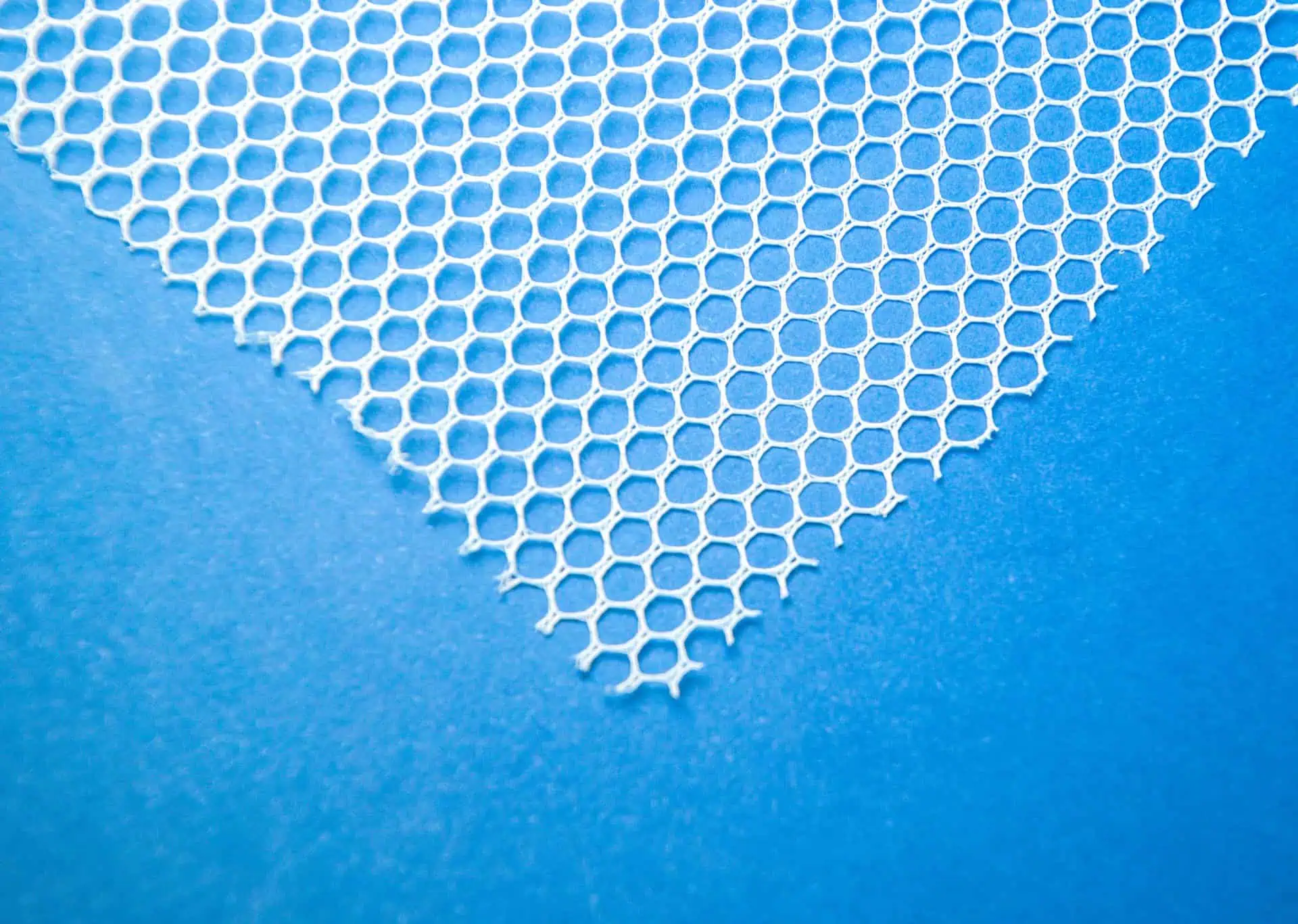Transvaginal Mesh Implants: What You Need To Know
- Last Updated: June 12th, 2025

Attorney Jessica Paluch-Hoerman, founder of TruLaw, has over 28 years of experience as a personal injury and mass tort attorney, and previously worked as an international tax attorney at Deloitte. Jessie collaborates with attorneys nationwide — enabling her to share reliable, up-to-date legal information with our readers.
Legally Reviewed
This article has been written and reviewed for legal accuracy and clarity by the team of writers and legal experts at TruLaw and is as accurate as possible. This content should not be taken as legal advice from an attorney. If you would like to learn more about our owner and experienced injury lawyer, Jessie Paluch, you can do so here.
Fact-Checked
TruLaw does everything possible to make sure the information in this article is up to date and accurate. If you need specific legal advice about your case, contact us by using the chat on the bottom of this page. This article should not be taken as advice from an attorney.
Key takeaways:
- Transvaginal mesh implants are used to treat pelvic organ prolapse and stress urinary incontinence by providing support to weakened pelvic floor muscles.
- There can be severe complications from transvaginal mesh implants, such as chronic pain, infection, and vaginal scarring. Therefore, discussing all potential risks and alternatives with a healthcare provider is essential.
- Alternative treatments, like physical therapy, injections of Botox, or synthetic materials around the bladder, exist for those looking for other options besides mesh implants.
Overview of Transvaginal Mesh Implants
On this page, we will discuss an overview of what you need to know about transvaginal mesh implants, harmful risks associated with transvaginal mesh implants, alternatives to transvaginal mesh implants, and much more.
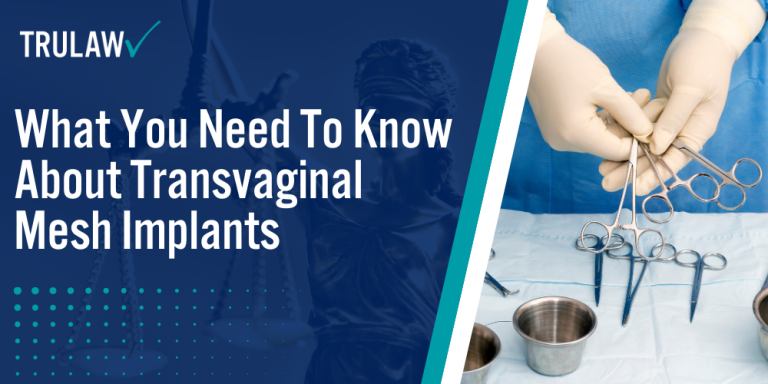
Intro to Transvaginal Mesh Implants
Essential insights into transvaginal mesh implants cover:
- Evaluating Benefits vs. Risks: It’s crucial to balance the potential advantages of transvaginal mesh implants with their associated risks before proceeding.
- Identifying Complications: Awareness of complications like mesh erosion, infection, and pain is important for patient decision-making.
- FDA Announcements: Staying informed about FDA safety communications regarding transvaginal mesh is vital for both patients and healthcare providers.
- Legal Rights and Actions: Patients experiencing adverse effects from mesh implants have pursued legal action, resulting in significant settlements.
Our experienced legal team offers insights into potential compensation, with settlement estimates ranging between $150,000 and $400,000.
Contact TruLaw using the chat on this page for a free consultation to determine eligibility for a transvaginal mesh lawsuit.
Table of Contents
Conditions Treated by Transvaginal Mesh Implants
Transvaginal mesh implants are medical devices designed to manage specific pelvic floor disorders that affect many women.
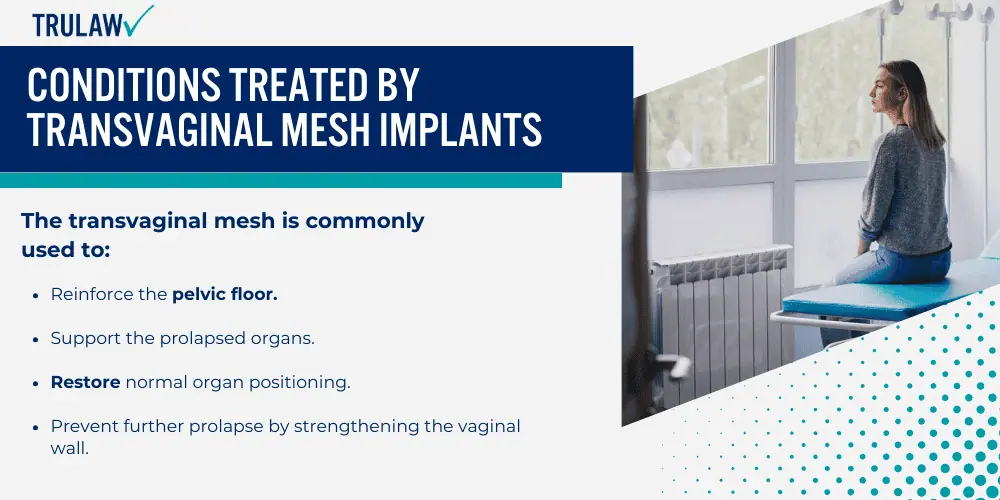
These implants provide support to weakened or damaged pelvic tissue.
Pelvic Organ Prolapse (POP)
Pelvic organ prolapse (POP) occurs when pelvic organs, such as the bladder, uterus, or rectum, descend into the vaginal canal due to weakened pelvic muscles.
The transvaginal mesh is commonly used to:
- Reinforce the pelvic floor.
- Support the prolapsed organs.
- Restore normal organ positioning.
- Prevent further prolapse by strengthening the vaginal wall.
Stress Urinary Incontinence (SUI)
Stress urinary incontinence (SUI) is another condition treated with transvaginal mesh, where involuntary urine leakage occurs during physical activities.
To treat stress urinary incontinence, surgeons may:
- Insert a mesh sling to support the urethra or bladder neck.
- Stabilize the urethra to prevent leakage.
- Reinforce the tissues to improve urethral closure.
- Enhance urinary control during activities that increase abdominal pressure.
In both POP and SUI treatment, the goal of a transvaginal mesh implant is to provide lasting support to the affected pelvic organs and improve the patient’s quality of life.
Transvaginal Mesh Implants: Procedure and Surgical Technique
Transvaginal mesh implants are utilized in surgical treatments for pelvic organ prolapse and stress urinary incontinence.
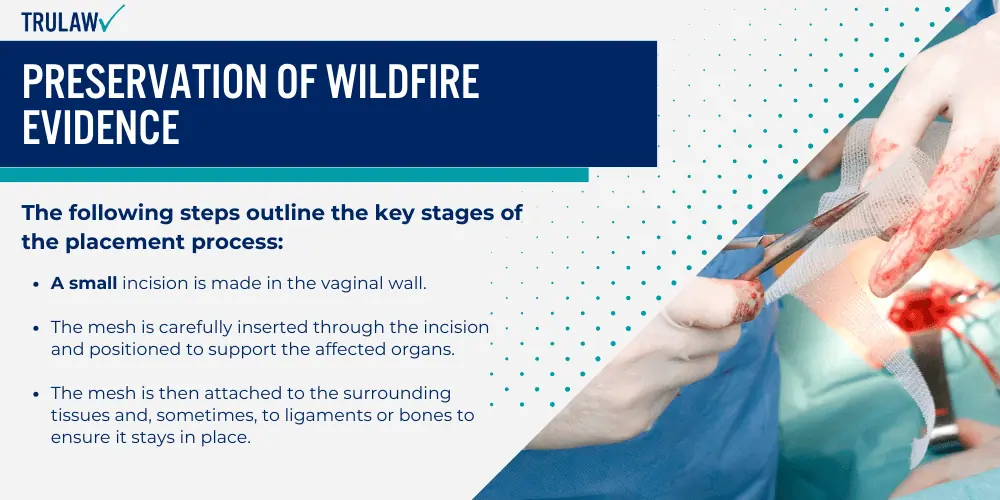
The procedure involves carefully placing or removing mesh through a small incision.
Transvaginal Mesh Placement
Transvaginal mesh placement is a surgical procedure designed to support weakened or damaged tissue in the pelvic area.
The following steps outline the key stages of the placement process:
- A small incision is made in the vaginal wall.
- The mesh is carefully inserted through the incision and positioned to support the affected organs.
- The mesh is then attached to the surrounding tissues and, sometimes, to ligaments or bones to ensure it stays in place.
- The incision is closed, and the mesh remains within the body to provide long-term reinforcement to the pelvic structure.
Transvaginal Mesh Removal
When removal is necessary due to complications or mesh failure, the procedure is meticulously planned and executed.
The steps often include:
- Opening the previous incision site and exposing the mesh.
- Detach the mesh from surrounding tissues delicately, minimizing further damage.
- Extraction of the mesh from the body.
- Rehabilitation of the incision site, which can include repairing any weakened tissue.
This surgical technique requires precision to ensure the patient’s safety and well-being, aiming for the best possible outcome following the procedure.
Effectiveness of Transvaginal Mesh Implants
The effectiveness of transvaginal mesh implants has been a topic of both controversy and evolution, with outcomes varying in terms of success rates and patient satisfaction.
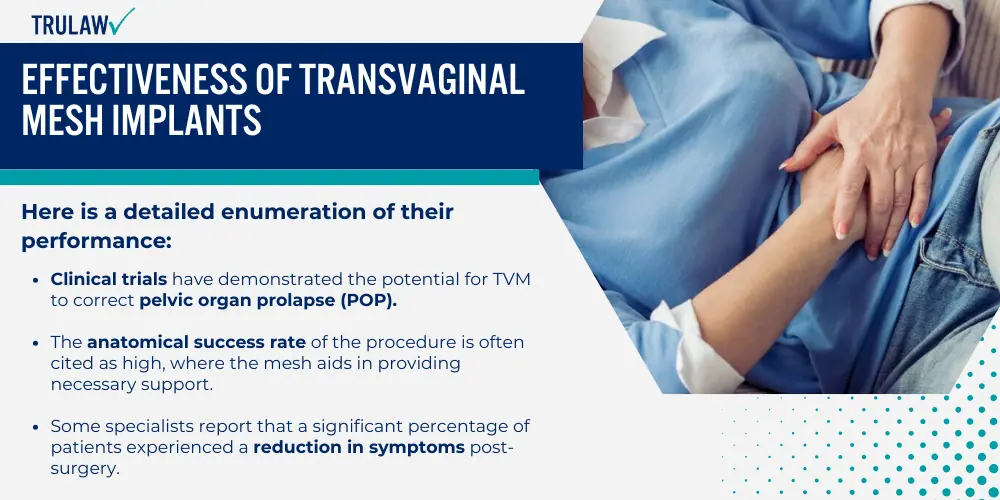
These implants are designed to treat pelvic floor disorders, including urinary incontinence.
Success Rates
Transvaginal mesh (TVM) implants have seen a varied spectrum of success.
Here is a detailed enumeration of their performance:
- Clinical trials have demonstrated the potential for TVM to correct pelvic organ prolapse (POP).
- The anatomical success rate of the procedure is often cited as high, where the mesh aids in providing necessary support.
- Some specialists report that a significant percentage of patients experienced a reduction in symptoms post-surgery.
- However, it is important to note the decline in the use of transvaginal mesh implants for POP repair after FDA warnings.
Patient Satisfaction
Ensuring patient satisfaction is paramount in the assessment of transvaginal mesh implant outcomes.
A patient’s sense of relief and improved well-being post-surgery is critical in evaluating the success of the procedure.
Factors contributing to patient satisfaction following a transvaginal mesh implant include:
- Improvement in quality of life when the implant successfully addresses urinary incontinence.
- Some patients report a return to normal activity without the discomfort of POP.
- Nevertheless, aspects such as post-surgical complications have impacted patient opinions negatively.
- The Long-term Follow-up of Transvaginal Anatomical Implant of Mesh in surgery patients indicates varied satisfaction connected to individual patient experiences.
Risks and Complications Associated With Transvaginal Mesh Implants
The use of transvaginal mesh (TVM) in pelvic organ prolapse surgeries has faced scrutiny due to potential risks and complications.
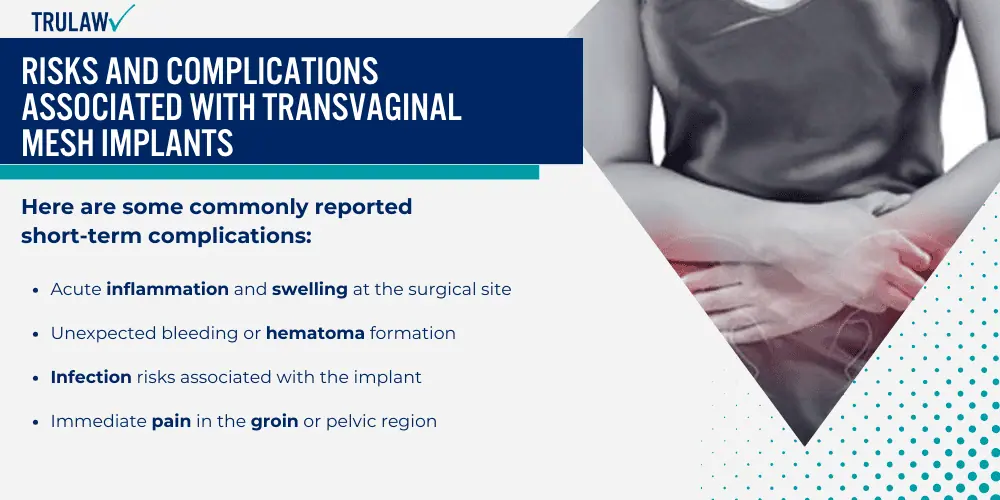
These can range from short-term issues immediately following surgery to serious long-term effects that may develop over time.
Short-Term Complications
After a TVM surgery, patients may experience a series of immediate complications.
Here are some commonly reported short-term complications:
- Acute inflammation and swelling at the surgical site
- Unexpected bleeding or hematoma formation
- Infection risks associated with the implant
- Immediate pain in the groin or pelvic region
Long-Term Complications
Long-term complications associated with transvaginal mesh implants can be more severe and potentially lead to additional medical interventions.
Consider the following long-term issues that patients might face:
- Persistent pelvic pain that can become debilitating
- Vaginal scarring that may lead to dyspareunia
- Damaged tissue and nerve damage, which might result in chronic discomfort
- Urinary problems, including incontinence or difficulty urinating
Mesh Exposure and Erosion
With time, the body may react unfavorably to the presence of the mesh.
The following points outline the risks related to mesh exposure and erosion:
- Mesh exposure, where the mesh becomes visible through the vaginal epithelium
- Mesh erosion, where the mesh wears through tissues and can cause complications
- Painful sexual intercourse due to mesh complications
- The need for additional surgery to remove or revise the eroded mesh
Regulatory and Safety Information on Transvaginal Mesh Implants
Transvaginal mesh implants have undergone rigorous scrutiny due to concerns over their safety and suitability for medical use.
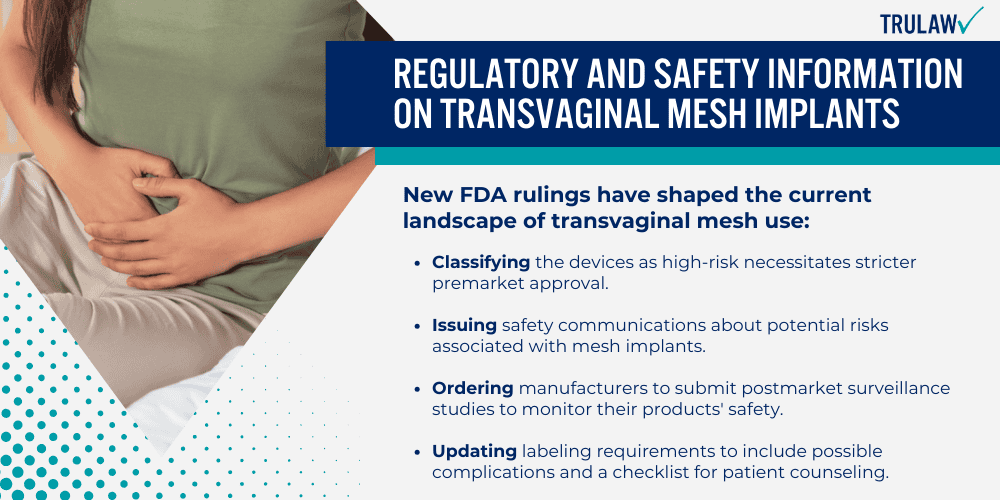
Regulatory bodies have stepped in to provide guidance and enforce standards to protect patient health.
FDA Rulings and Recommendations
The Food and Drug Administration (FDA) has played a crucial role in overseeing medical devices, including surgical mesh devices.
New FDA rulings have shaped the current landscape of transvaginal mesh use:
- Classifying the devices as high-risk necessitates stricter premarket approval.
- Issuing safety communications about potential risks associated with mesh implants.
- Ordering manufacturers to submit postmarket surveillance studies to monitor their products’ safety.
- Updating labeling requirements to include possible complications and a checklist for patient counseling.
These actions reflect the FDA’s commitment to ensuring the safety and effectiveness of medical devices, particularly in the context of transvaginal mesh used for pelvic organ prolapse repair.
Current Best Practices
As the medical community has adapted to evolving insights and regulatory changes, the approach to transvaginal mesh implants has significantly shifted.
These changes are reflected in a set of rigorous best practices aimed at enhancing patient safety and treatment efficacy.
In light of the updated regulations and a better understanding of the risks, best practices have been established for the use of transvaginal mesh implants:
- Selecting patients carefully and considering all alternative treatments before opting for surgical mesh.
- Informed consent is crucial, with clinicians ensuring patients understand the potential risks and complications.
- Credentialing practitioners to perform transvaginal mesh surgeries, ensuring their competency in the procedure.
- Monitoring outcomes post-surgery, with a framework for reporting and managing any adverse events.
Alternatives to Transvaginal Mesh Implants
While transvaginal mesh implants have been a common treatment for pelvic organ prolapse (POP), concerns over associated risks have led to a demand for alternative treatment options.
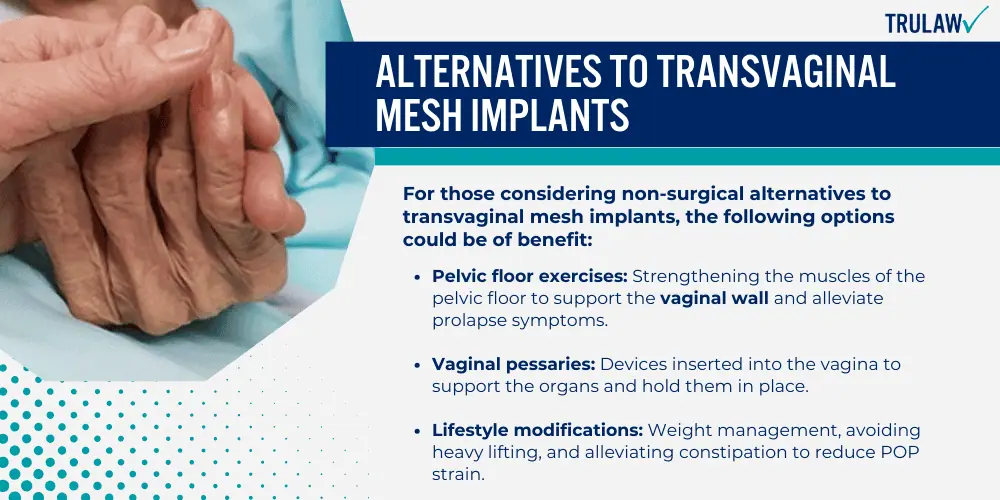
This section explores various alternatives available for women seeking treatment for POP.
Non-Surgical Treatments
While transvaginal mesh implants are a common solution for pelvic organ prolapse, they are not the only option available.
Patients may explore a variety of non-surgical treatments that offer relief and management of symptoms without the need for invasive procedures.
For those considering non-surgical alternatives to transvaginal mesh implants, the following options could be of benefit:
- Pelvic floor exercises: Strengthening the muscles of the pelvic floor to support the vaginal wall and alleviate prolapse symptoms.
- Vaginal pessaries: Devices inserted into the vagina to support the organs and hold them in place.
- Lifestyle modifications: Weight management, avoiding heavy lifting, and alleviating constipation to reduce POP strain.
- Physical therapy: Guided sessions to improve pelvic muscle control and support.
Native Tissue Repair
Native tissue repair is an effective surgical alternative that does not involve the use of mesh implants.
Key components of this procedure include:
- Reconstructive surgery: Realigning and securing the prolapsed organs into their original position using the patient’s own tissues.
- Uterosacral ligament suspension: Elevating the apex of the vagina by attaching it to the uterosacral ligaments.
- Sacrospinous fixation: A procedure that attaches the vaginal vault to the sacrospinous ligament.
- Anterior and posterior colporrhaphy: Tightening the front or back walls of the vagina to treat cystocele or rectocele.
Other Surgical Options
For patients seeking alternatives to transvaginal mesh implants, modern medicine offers a range of other surgical methods, each with its own benefits and considerations.
Often preferred for specific clinical scenarios, these options provide diverse approaches to addressing pelvic organ prolapse.
In addition to native tissue repair, several other surgical treatment options serve as alternatives to transvaginal mesh implants:
- Biological graft repair: Utilizes grafts from human or animal tissue for vaginal wall support.
- Autologous fascial sling: Using the patient’s own tissue to create a sling beneath the urethra for support.
- Robotic surgery: Advanced, minimally invasive procedures that can address prolapse with precision and reduced recovery times.
- Laparoscopic sacrocolpopexy: A keyhole surgery approach to attach the vagina to the sacral promontory, providing support.
Complications of Living With Transvaginal Mesh Implants
Those who have undergone transvaginal mesh implantation may face several complications that affect daily life, demanding both lifestyle alterations and ongoing support for rehabilitation.
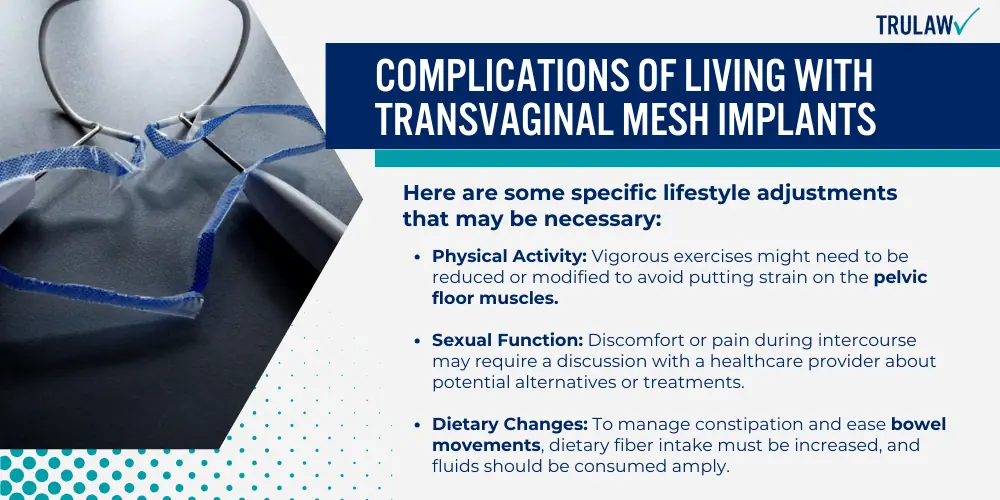
Lifestyle Adjustments
Individuals living with transvaginal mesh implants often find that their daily routines need modification to accommodate changes in their bodies.
Here are some specific lifestyle adjustments that may be necessary:
- Physical Activity: Vigorous exercises might need to be reduced or modified to avoid putting strain on the pelvic floor muscles.
- Sexual Function: Discomfort or pain during intercourse may require a discussion with a healthcare provider about potential alternatives or treatments.
- Dietary Changes: To manage constipation and ease bowel movements, dietary fiber intake must be increased, and fluids should be consumed amply.
- Clothing Choices: Tight-fitting garments may exacerbate discomfort; hence, looser and more comfortable options are preferred.
Support and Rehabilitation
After surgery, a detailed plan for support and rehabilitation can help manage complications and improve quality of life.
Essential aspects of this plan include:
- Physical Therapy: Strengthening the pelvic floor with targeted exercises can help provide better support to the weakened vaginal wall.
- Pain Management: Upon experiencing discomfort or chronic pain post-surgery, patients may require pain management strategies.
- Psychological Support: The emotional impact of complications should not be overlooked and psychological support or counseling might be beneficial.
- Medical Follow-Up: Regular check-ups with a healthcare provider are crucial to monitor for any mesh-related issues and to address them promptly.
Emerging Trends and Research on Transvaginal Mesh Implants
Recent advancements in the field of urogynecology have led to innovative approaches in the use of transvaginal mesh implants.
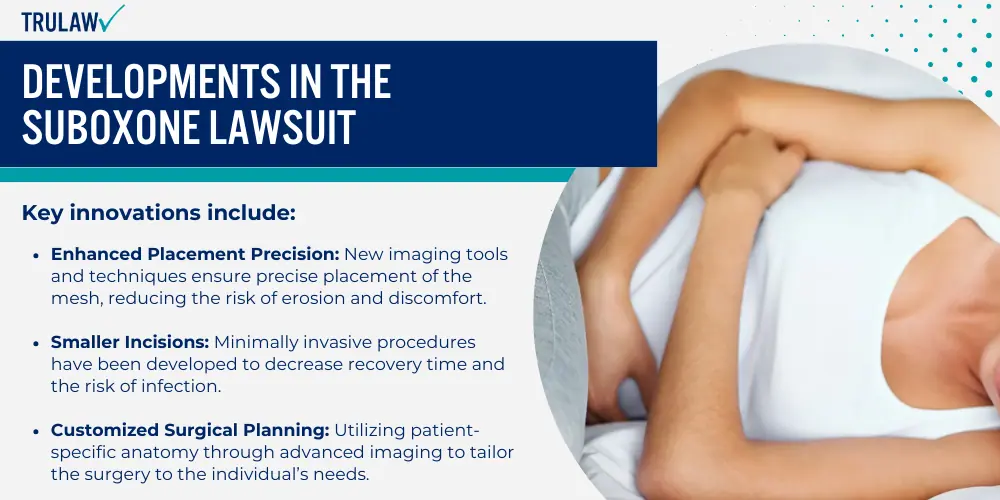
Research has concentrated on refining surgical methods and developing new mesh materials that offer improved outcomes and safety profiles for patients.
Innovations in Surgical Techniques
The application of mesh slings in urogynecological surgery has evolved, with techniques focusing on minimizing complications and enhancing efficacy.
Key innovations include:
- Enhanced Placement Precision: New imaging tools and techniques ensure precise placement of the mesh, reducing the risk of erosion and discomfort.
- Smaller Incisions: Minimally invasive procedures have been developed to decrease recovery time and the risk of infection.
- Customized Surgical Planning: Utilizing patient-specific anatomy through advanced imaging to tailor the surgery to the individual’s needs.
- Robot-Assisted Surgery: Incorporating robotic systems to improve the accuracy of mesh placement and suturing.
These procedural enhancements aim to increase the success rate of surgeries involving pelvic mesh implants and reduce postoperative complications.
Next-Generation Mesh Materials
In response to historical challenges associated with vaginal mesh implants, significant efforts are being made to identify and use materials that are safer and better tolerated by the body.
Pioneering materials in development include:
- Biocompatible Synthetics: The focus is on creating synthetic materials that mimic the body’s natural tissue response, thereby reducing rejection.
- Bioresorbable Meshes: These meshes are designed to provide temporary support and dissolve once the native tissue has healed.
- Composite Meshes: Combining different materials to maximize strength and flexibility while minimizing adverse reactions.
- Nanofiber Technology: Employing nanoscale fibers to create a mesh structure that minimizes tissue irritation and promotes integration.
By exploring these innovative synthetic materials, the new generation of meshes aims to provide a balance between durability and safety, thereby improving the quality of life for recipients of vaginal mesh implants.
Patient Resources For Transvaginal Mesh Implants
Patients seeking information on transvaginal mesh implants have access to comprehensive resources that can assist with understanding the procedure, managing mesh complications, and considering options for prolapsed organs or reconstructive surgery.
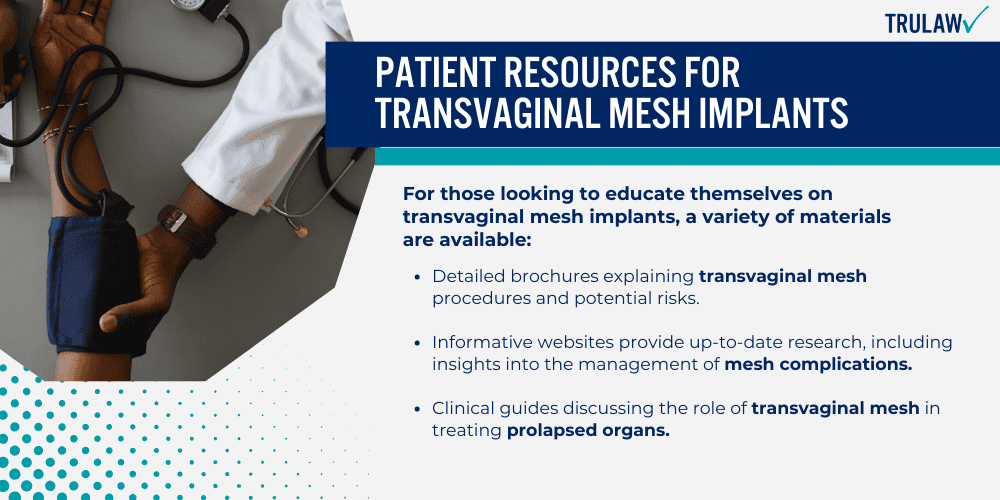
Educational Materials
Gaining a thorough understanding of transvaginal mesh implants is crucial for informed decision-making, and fortunately, there is a wealth of educational resources available.
These materials range from in-depth explanations of the procedure to insights on managing potential complications.
For those looking to educate themselves on transvaginal mesh implants, a variety of materials are available:
- Detailed brochures explaining transvaginal mesh procedures and potential risks.
- Informative websites provide up-to-date research, including insights into the management of mesh complications.
- Clinical guides discussing the role of transvaginal mesh in treating prolapsed organs.
- Videos from medical professionals explaining the process of reconstructive surgery and recovery expectations.
Support Groups
Joining a support group can provide valuable assistance and empathy when navigating life after a transvaginal mesh implant.
These groups provide a safe environment for individuals to connect, share their stories, and find comfort in knowing they are not alone.
Individuals impacted by transvaginal mesh implants can find support through several channels:
- Online forums where patients share personal experiences with mesh complications and offer mutual encouragement.
- Local patient groups provide a space to discuss challenges and solutions related to living with prolapsed organs or post-reconstructive surgery recovery.
- Social media communities that offer real-time support and guidance for those coping with the effects of transvaginal mesh.
- Scheduled virtual meetings that connect individuals with professionals for in-depth discussions about prognosis and treatment options.
Legal Considerations and Rights
Transvaginal mesh implants have led to significant legal discussions, focusing on patient rights and manufacturers’ responsibility.
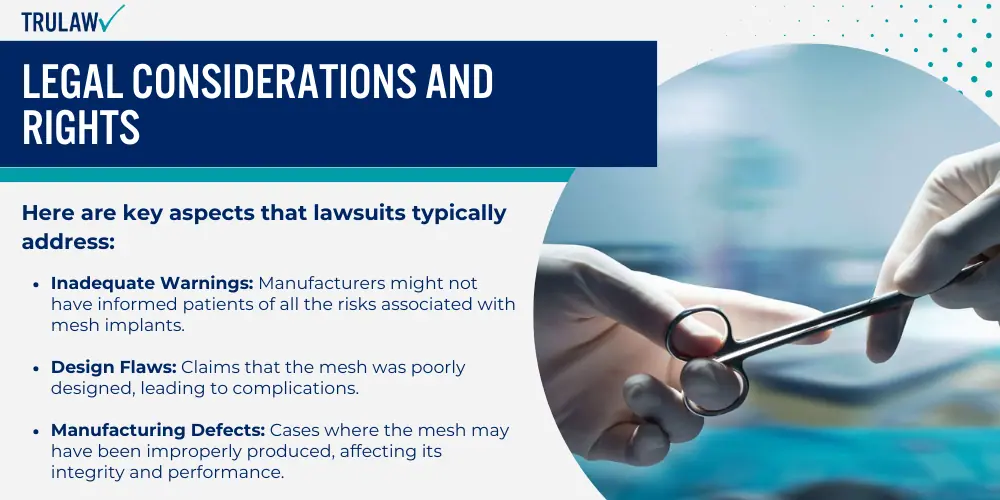
Legal actions pertain to the complications from these devices and the medical industry’s accountability in ensuring their safety.
Product Liability Lawsuits
Patients’ legal actions have often been centered on product liability, with allegations that mesh manufacturers failed to warn of potential risks properly and that devices were defective.
Here are key aspects that lawsuits typically address:
- Inadequate Warnings: Manufacturers might not have informed patients of all the risks associated with mesh implants.
- Design Flaws: Claims that the mesh was poorly designed, leading to complications.
- Manufacturing Defects: Cases where the mesh may have been improperly produced, affecting its integrity and performance.
- Negligent Marketing: Allegations that manufacturers’ marketing efforts did not include sufficient safety warnings or misrepresented the product’s safety.
- Failure to Test: Lawsuits often argue that adequate testing was not conducted to ensure the safety of the mesh before it was brought to market.
- Complications Post-Surgery: Plaintiffs frequently report a range of complications post-implant, such as infections, pain, and mesh erosion.
In many scenarios, settlements or court decisions have resulted in compensation for the affected individuals, with detailed analysis of the associated medical industry accountability.
Patient Advocacy Efforts
Alongside individual lawsuits, collective patient advocacy has become a vital platform for those affected by transvaginal mesh implants.
These efforts often focus on:
- Increasing Public Awareness: Campaigns are often designed to educate the public about the risks associated with mesh implants.
- Support Networks: Create support groups that provide emotional and practical support to individuals affected by mesh-related complications.
- Push for Regulatory Changes: Advocates frequently lobby for stricter regulations regarding the approval and monitoring of surgical meshes.
- Information Dissemination: Efforts to distribute information on legal rights and resources available to affected patients.
These advocacy groups have been instrumental in informing policy changes and assisting individuals in navigating their legal rights and options for recourse.
As the medical community continues to understand the breadth of mesh-related complications and surgical mesh considerations, the legal landscape similarly evolves, reflecting the ongoing concerns and experiences of affected patients.
Professional Perspectives on Transvaginal Mesh Implants
Transvaginal mesh implants have garnered diverse opinions among professionals due to their application in female pelvic reconstructive surgery and their effectiveness in prolapse repairs.
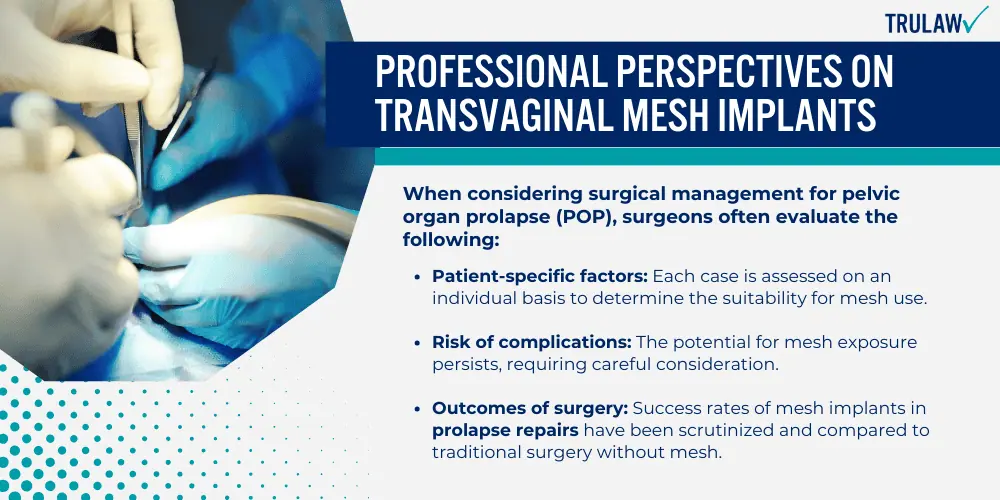
Surgeon’s Insights
Surgeons have accumulated extensive insights into the efficacy of transvaginal mesh implants for the treatment of prolapse.
When considering surgical management for pelvic organ prolapse (POP), surgeons often evaluate the following:
- Patient-specific factors: Each case is assessed on an individual basis to determine the suitability for mesh use.
- Risk of complications: The potential for mesh exposure persists, requiring careful consideration.
- Outcomes of surgery: Success rates of mesh implants in prolapse repairs have been scrutinized and compared to traditional surgery without mesh.
- Technique evolution: The surgical techniques involving mesh have evolved to minimize risks and improve outcomes.
Surgeons acknowledge that while the implantation technique has become simple, complications such as mesh exposure have prompted criticism.
Global Health Views
The global medical community’s approach to transvaginal mesh implants is a topic of ongoing debate and scrutiny, marked by differing policies and perspectives from various countries.
This international discourse reflects a deeper exploration into the balance of safety, efficacy, and patient well-being in medical practices.
Across the globe, health entities have confronted the issue of transvaginal mesh use, leading to a spectrum of regulatory actions:
- Regulation differences: Countries like the USA, UK, Canada, and Australia have unique regulations surrounding transvaginal mesh.
- Safety and efficacy debates: Despite approval in the 1990s, recent discourse questions the initial lack of supporting clinical trials.
- Public concerns: The general public’s perception has influenced the direction of regulations and continued use.
- International collaboration: The medical community has engaged in international discussions to harmonize perspectives and guidelines on mesh use.
Diverse opinions and recommendations reflect the ongoing debate among global health professionals regarding transvaginal mesh use.
Conclusion
Transvaginal mesh implants are medical devices used in the treatment of pelvic organ prolapse, a condition where pelvic organs descend due to a weakened pelvic floor.
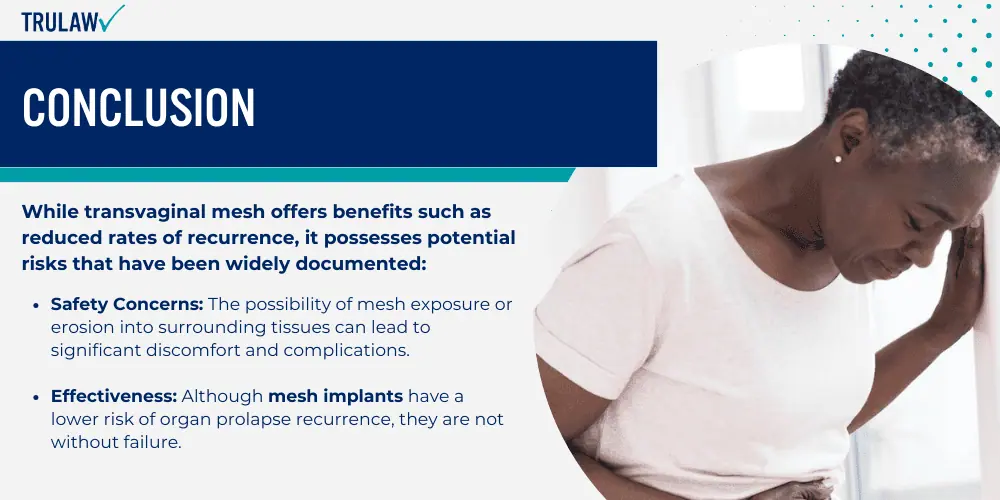
While transvaginal mesh offers benefits such as reduced rates of recurrence, it possesses potential risks that have been widely documented:
- Safety Concerns: The possibility of mesh exposure or erosion into surrounding tissues can lead to significant discomfort and complications.
- Effectiveness: Although mesh implants have a lower risk of organ prolapse recurrence, they are not without failure.
- Surgical Outcomes: Patients undergoing procedures with mesh implants may have varied results, influencing their long-term quality of life.
- Legal Aspects: There are numerous legal considerations and actions surrounding the use of transvaginal mesh due to reported complications.
Providers ascertain the suitability of mesh implants for each case by addressing the necessity of individual patient assessment.
They emphasize the importance of a thorough evaluation of both the potential benefits and risks.
In particular scenarios, alternative treatments may be recommended:
- Conservative Management: Pelvic floor exercises or pessary use are non-surgical options.
- Native Tissue Repair: Strategies relying on the body’s tissues may be considered.
- Non-Mesh Surgery: Alternatives that do not involve mesh but offer repair are explored.
- Watchful Waiting: Monitoring the condition’s progression before deciding on surgery.
The decision to utilize transvaginal mesh should be made cautiously, taking into account the individual circumstances of each patient.
It remains imperative that ongoing research and monitoring of mesh implants continue to ensure patient safety and the effectiveness of therapeutic interventions.
Transvaginal Mesh Lawsuit Frequently Asked Questions
-
What are the common complications associated with transvaginal mesh surgery?
Transvaginal mesh surgery can lead to several complications.
These typically include mesh erosion into the vagina, pain during intercourse, and infections.
In some cases, patients may also experience urinary problems or recurring prolapse.
-
What alternatives to transvaginal mesh are available for pelvic organ prolapse?
For treating pelvic organ prolapse without transvaginal mesh, several alternatives exist.
These include pelvic floor physical therapy to strengthen the muscles, a pessary which is a device inserted into the vagina to support the pelvic organs, and non-mesh surgical options such as traditional native tissue repair.
-
How do bladder mesh side effects manifest, and how serious can they be?
Side effects from a bladder mesh may present as persistent urinary tract infections and discomfort in the pelvic region.
These side effects can range from mild to severe, potentially leading to reduced quality of life and the need for additional surgeries.
-
What legal avenues can be pursued in the case of transvaginal mesh failure?
Victims of transvaginal mesh failure have legal options, including filing a personal injury lawsuit against the manufacturer.
There are also class action lawsuits and possibilities for settlements, as seen in some major cases involving mesh manufacturers.
-
In what types of surgery is pelvic mesh typically utilized?
Pelvic mesh is commonly used in surgical procedures to address conditions such as hernias, stress urinary incontinence (SUI), and pelvic organ prolapse (POP).
Its application provides support and reinforcement to the affected tissues or organs.
-
How does transvaginal mesh implantation affect subsequent medical procedures, like hysterectomy?
The presence of transvaginal mesh can complicate further medical procedures.
For example, during a hysterectomy, the surgical process may be more complex due to scar tissue and the integration of the mesh with surrounding tissues, requiring meticulous surgical planning and technique.

Managing Attorney & Owner
With over 25 years of legal experience, Jessica Paluch-Hoerman is an Illinois lawyer, a CPA, and a mother of three. She spent the first decade of her career working as an international tax attorney at Deloitte.
In 2009, Jessie co-founded her own law firm with her husband – which has scaled to over 30 employees since its conception.
In 2016, Jessie founded TruLaw, which allows her to collaborate with attorneys and legal experts across the United States on a daily basis. This hypervaluable network of experts is what enables her to share the most reliable, accurate, and up-to-date legal information with our readers!
Additional Transvaginal Mesh Lawsuit resources on our website:
Here, at TruLaw, we’re committed to helping victims get the justice they deserve.
Alongside our partner law firms, we have successfully collected over $3 Billion in verdicts and settlements on behalf of injured individuals.
Would you like our help?
At TruLaw, we fiercely combat corporations that endanger individuals’ well-being. If you’ve suffered injuries and believe these well-funded entities should be held accountable, we’re here for you.
With TruLaw, you gain access to successful and seasoned lawyers who maximize your chances of success. Our lawyers invest in you—they do not receive a dime until your lawsuit reaches a successful resolution!
AFFF Lawsuit claims are being filed against manufacturers of aqueous film-forming foam (AFFF), commonly used in firefighting.
Claims allege that companies such as 3M, DuPont, and Tyco Fire Products failed to adequately warn users about the potential dangers of AFFF exposure — including increased risks of various cancers and diseases.
Depo Provera Lawsuit claims are being filed by individuals who allege they developed meningioma (a type of brain tumor) after receiving Depo-Provera birth control injections.
A 2024 study found that women using Depo-Provera for at least 1 year are five times more likely to develop meningioma brain tumors compared to those not using the drug.
Suboxone Tooth Decay Lawsuit claims are being filed against Indivior, the manufacturer of Suboxone, a medication used to treat opioid addiction.
Claims allege that Indivior failed to adequately warn users about the potential dangers of severe tooth decay and dental injuries associated with Suboxone’s sublingual film version.
Social Media Harm Lawsuits are being filed against social media companies for allegedly causing mental health issues in children and teens.
Claims allege that companies like Meta, Google, ByteDance, and Snap designed addictive platforms that led to anxiety, depression, and other mental health issues without adequately warning users or parents.
Transvaginal Mesh Lawsuits are being filed against manufacturers of transvaginal mesh products used to treat pelvic organ prolapse (POP) and stress urinary incontinence (SUI).
Claims allege that companies like Ethicon, C.R. Bard, and Boston Scientific failed to adequately warn about potential dangers — including erosion, pain, and infection.
Bair Hugger Warming Blanket Lawsuits involve claims against 3M — alleging their surgical warming blankets caused severe infections and complications (particularly in hip and knee replacement surgeries).
Plaintiffs claim 3M failed to warn about potential risks — despite knowing about increased risk of deep joint infections since 2011.
Baby Formula NEC Lawsuit claims are being filed against manufacturers of cow’s milk-based baby formula products.
Claims allege that companies like Abbott Laboratories (Similac) and Mead Johnson & Company (Enfamil) failed to warn about the increased risk of necrotizing enterocolitis (NEC) in premature infants.
Here, at TruLaw, we’re committed to helping victims get the justice they deserve.
Alongside our partner law firms, we have successfully collected over $3 Billion in verdicts and settlements on behalf of injured individuals.
Would you like our help?
